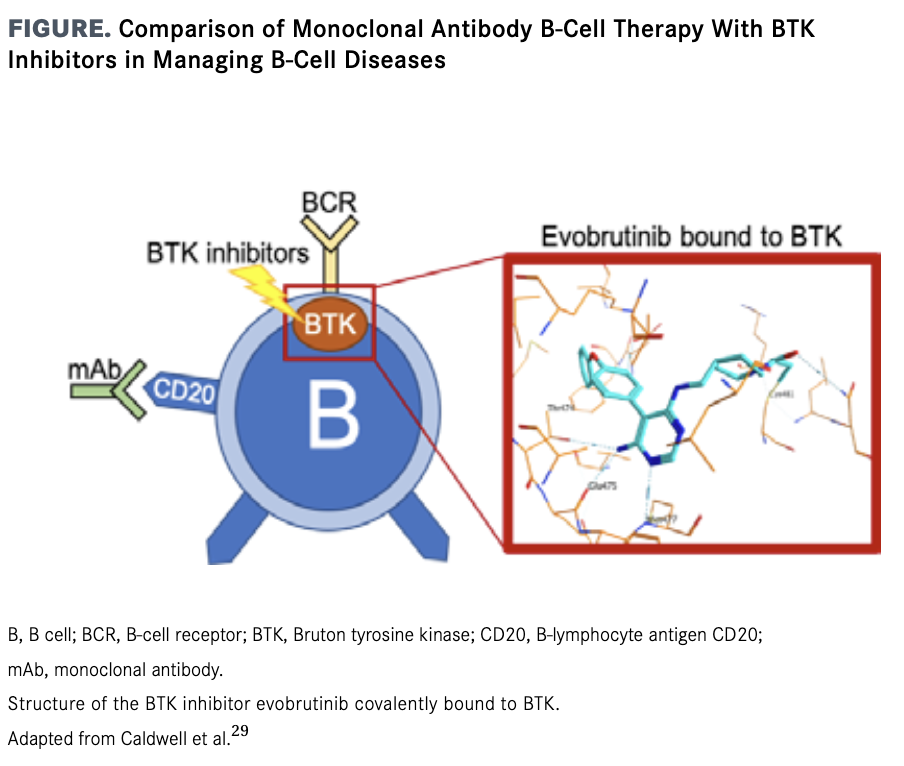July 2, 2020 /
An in-depth look into the expanding landscape of multiple sclerosis treatments that target bruton tyrosine kinase.
By: Jennifer S. Sun, PhD – June 30, 2020
By: Jennifer S. Sun, PhD – June 30, 2020
Bruton Tyrosine Kinase (BTK), a Tec family nonreceptor tyrosine kinase1 critical for the development of B cells and several other hematopoietic lineages2 (except for T cells, plasma cells, and natural killer cells3), is a recent focus of therapeutics.4 BTK informs immune responses by acting as an early downstream amplification enzyme of the B-cell antigen receptor (BCR)5-8 and cytokine receptor pathways.8,9 BTK signaling influences antigen presentation on B cells10 and is essential to the production of antibodies, proinflammatory cytokines and chemokines, and cell adhesion molecules.11,12 Through these mechanisms, BTK helps transmit the signals that allow immune cells to respond to foreign antigens by targeting the cells presenting them for destruction.13-15Harmful consequences arise when the immune system mistakes self-proteins as foreign antigens, with BTK promoting autoantibody secretion by autoreactive B cells.8,14,15 Autoimmune diseases such as multiple sclerosis (MS)16 result from this dysregulated production of autoantibodies, which leads to destruction of normal tissue.17 Malfunctioning BTK mutants have been linked to increased disease susceptibility, correlating with diminished numbers of mature B cells and immunoglobulin isotypes.18,19 BTK therefore serves as an important target for therapeutic agents that modulate innate immunity.Interactions between T cells, B cells, and myeloid cells promote MS pathology,16 and BTK is a component of signaling events with a critical role in regulating hematopoietic cell circulation.20 MS is a chronic, inflammatory, demyelinating disease of the central nervous system21 and is the most common, nontraumatic, disabling neurological autoimmune disease, with approximately 2.3 million cases diagnosed worldwide.22 B cells contribute to MS pathogenesis as a result of being skewed toward a proinflammatory profile involving antibody production, antigen presentation, T-cell stimulation, production of proinflammatory cytokines, formation of ectopic meningeal germinal centers, and deposition of oligoclonal bands of immunoglobulin in areas of active demyelination.23-25 Briefly, the body’s immune system begins to attack myelin, a protective sheath covering nerve fibers. The nervous system is consequently “short-circuited,” potentially permanently.26Treatments for MS aim to shorten the duration and severity of relapses, prolong the time between relapses, and delay progression of disability.27 The most well-studied type of therapy targeting B cells consists of monoclonal antibodies (mAbs) that deplete B cells through mechanisms of antibody-dependent cellular cytotoxicity and apoptosis.23 Rituximab, for example, a mAb targeting the B-cell antigen CD20, depletes B cells and reduces T cells in the cerebrospinal fluid. However, rituximab is incapable of penetrating the blood-brain barrier (BBB) or lymphoid organs and is unsuccessful in slowing disease progression.23,28 To overcome the limitations of mAbs,28 MS treatment efforts have turned to BTK inhibitors (FIGURE).29

The ideal BTK inhibitor would be a rapidly reversible, BBB-penetrant, highly selective, modulatory approach to target B-cell activation without widespread depletion of B cells.8,9,23,30,31 Rather, the B-cell response to BCR stimuli is lowered, tolerogenic B cells are maintained, and antigen-mediated proinflammatory activation is neutralized.8,12,15,31 BTK is already a target in treatment of lymphoma, leukemia, and rheumatoid arthritis via the prominent BTK inhibitor ibrutinib. However, ibrutinib exhibits off-target kinase-inhibitory effects and is associated with immunosuppression and bleeding complications.32-34 BTK inhibitors in development for chronic administration thus have more refined pharmacologic profiles, including high BTK selectivity and moderate clearance.29,35
::::::::::::::::::::::::::::::::::::::;;;;;;;;;;;;;;;;;;;;;::::::::::::::::::::::::::::::::::::::::::::::::::::::::::::::
Information Shared by: MSViewsandNews,
to and for those affected by Multiple Sclerosis
::::::::::::::::::::::::::::::::::::::;;;;;;;;;;;;;;;;;;;;;:::::::::::::::::::::::::::::::::::::::::::::::::::::::::::::
Visit our MS Learning Channel on YouTube: http://www.youtube.com/msviewsandnews
Stay informed with MS news and information - Sign-up here
For MS patients, caregivers or clinicians, Care to chat about MS? Join Our online COMMUNITY CHAT



